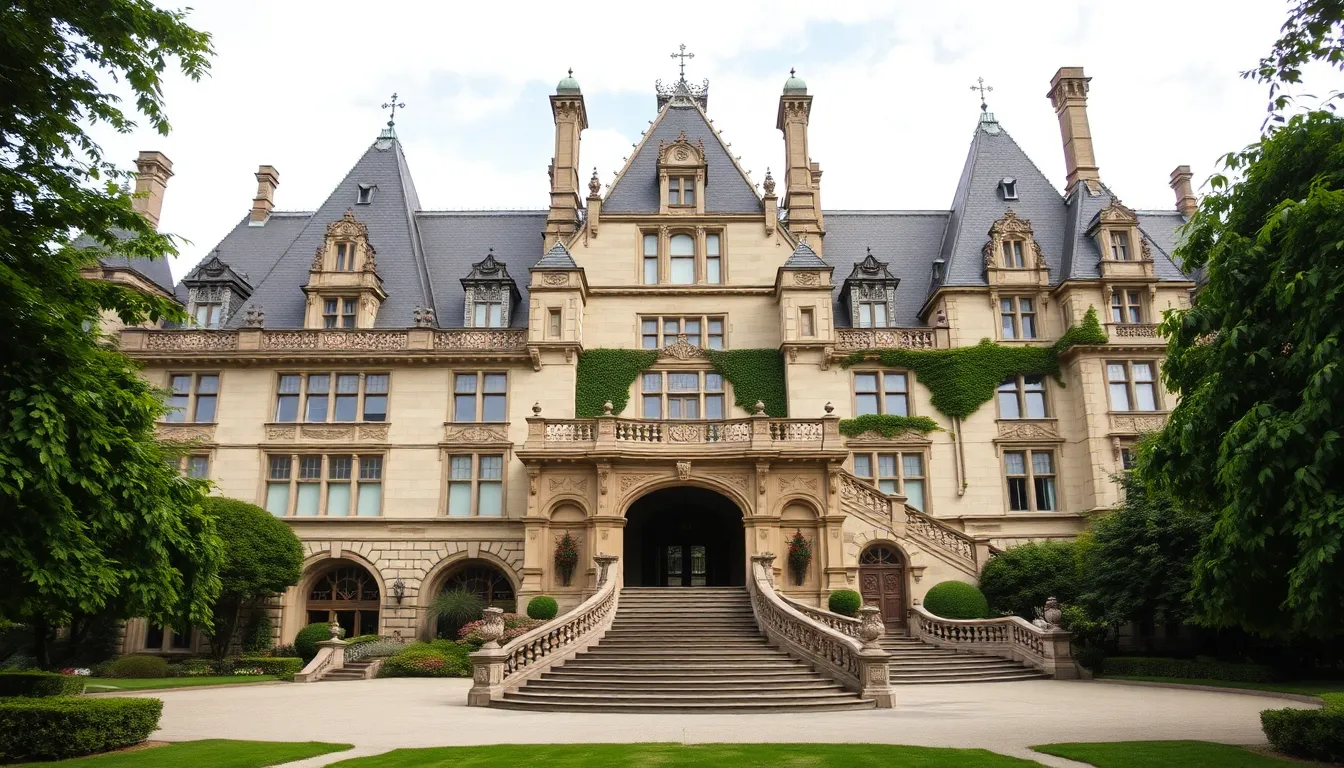Nestled in the Blue Ridge Mountains, the Biltmore Estate stands as a testament to opulence and grandeur. But just how much is this architectural marvel worth? With its sprawling gardens and breathtaking views, it’s not just a home; it’s a slice of American history that’s worth its weight in gold—or at least in fancy chandeliers.
Table of Contents
ToggleOverview of the Biltmore Estate
Biltmore Estate, nestled in the Blue Ridge Mountains of North Carolina, stands as America’s largest privately owned home. Constructed by George Washington Vanderbilt II in the late 19th century, it showcases over 250 rooms, extensive gardens, and breathtaking vistas. The estate spans 8,000 acres, featuring diverse landscapes that attract visitors year-round.
Visitors frequently admire the stunning architecture, which draws from the styles of French châteaux, creating a striking visual experience. Over time, the estate has become a significant cultural landmark, symbolizing the Gilded Age’s grandeur. Its historical importance extends beyond mere aesthetics, highlighting innovations in agriculture and preservation efforts.
Luxury amenities include a winery, outdoor activities, and seasonal events, enhancing the estate’s appeal. The gardens, designed by renowned landscape architect Frederick Law Olmsted, feature elaborate floral arrangements, well-maintained paths, and picturesque water features, providing visitors with a serene environment.
Valuing the Biltmore Estate is complex, reflecting its rich history and architectural significance. Recent estimates place its worth at around $250 million, factoring in both its historical legacy and its flourishing tourism sector. By embracing sustainability practices, the estate remains a beacon of conservation while attracting over a million guests annually.
Touring the estate offers an immersive experience in history and luxury. With guided tours available, guests learn about the Vanderbilt family, the construction process, and the estate’s evolution. Biltmore Estate represents much more than a lavish home; it serves as a vital piece of American heritage and culture, highlighting the interplay between nature and architecture.
Historical Value of the Biltmore Estate

The Biltmore Estate holds immense historical value, combining architectural brilliance with cultural significance.
Construction and Design
Crafted between 1889 and 1895, the Biltmore showcases a combination of Richard Morris Hunt’s architectural vision and inspiration from French châteaux. Spanning over 250 rooms, its intricate details highlight lavish materials and fine craftsmanship. Furthermore, the estate’s expansive gardens, designed by Frederick Law Olmsted, reflect the beauty of nature intertwined with human creativity. Visitors frequently admire the grand staircase and sumptuous interiors, which embody the luxury of the Gilded Age. Such design choices serve as a testament to Vanderbilt’s commitment to artistic excellence.
Historical Significance
The Biltmore Estate represents a pivotal moment in American history. It symbolized the opulence of the Gilded Age while showcasing advancements in agriculture and land management practices. Additionally, George Vanderbilt II transformed the estate into a model for sustainable farming, influencing future generations. Historical narratives surrounding the estate reveal much about America’s economic and social evolution during that time. This legacy continues to captivate millions of visitors, helping them connect with the past deeply. Events and exhibitions hosted at the estate emphasize its educational role within American heritage.
Current Market Value
The Biltmore Estate’s market value reflects its historical significance and unique offerings. Current estimates suggest the estate is worth approximately $250 million. Various elements contribute to its impressive valuation.
Factors Influencing Worth
Location plays a significant role in determining worth. Nestled in the scenic Blue Ridge Mountains, the estate benefits from tourism and natural beauty. Additionally, historical importance enhances its value due to its representation of the Gilded Age. The estate’s architectural grandeur, featuring more than 250 rooms and meticulously designed gardens, adds to its appeal. Revenue generated from events and experiences further reinforces its valuation. The commitment to sustainability in its agricultural practices also attracts environmentally conscious visitors.
Recent Appraisals
Appraisals have varied over the years. A recent evaluation estimated the estate’s worth at about $250 million, consistent with its history and cultural influence. Assessors consider the estate’s extensive grounds, luxury amenities, and visitor engagement. Insights from the tourism sector indicate a steady influx of over a million guests annually. This popularity influences its financial performance, making it a valuable asset in the real estate market. Enhanced by the annual events and exhibitions, the estate maintains its relevance and draws attention, positively impacting its overall worth.
Comparisons with Other Historic Properties
Valuing the Biltmore Estate becomes more insightful when compared to similar historic properties. Monticello, the home of Thomas Jefferson, represents another significant example of American heritage. Valued at approximately $200 million, Monticello echoes similar themes of historical importance and architectural beauty.
Similarly, the Newport Mansions in Rhode Island, including The Breakers, highlight the lavish lifestyles of America’s elite during the Gilded Age. These properties collectively carry a worth estimated at around $400 million. Remarkably, both the Biltmore and the Newport Mansions attract numerous visitors each year, enhancing their economic and cultural significance.
Exploring these properties reveals shared characteristics beyond their market values. Each estate invites visitors with its rich history and architectural splendor, much like the Biltmore’s ornate interiors and expansive gardens. The inclusion of wineries, gardens, and seasonal events further ties them together as destinations for luxury experiences.
Historic sites across the nation often experience fluctuating market values influenced by factors such as tourism and maintenance. The Biltmore Estate’s strategic investments in sustainability and visitor services enhance its appeal in a competitive market. This approach reflects wider tourism trends noted at many historic properties.
In addition, Gladys Taber’s Shelburne Farms in Vermont conveys similar principles of agricultural innovation. This property emphasizes sustainable practices, echoing the Biltmore’s commitment to environmental stewardship. Comparatively, the emphasis on both historical aesthetics and modern sustainability strengthens the significance of these estates within the broader context of American culture.
Economic Impact on Asheville, NC
The Biltmore Estate significantly contributes to Asheville’s economy. Employment opportunities arise from its operation, attracting over 1,000 full-time employees and numerous seasonal staff. Local businesses thrive as visitors frequently shop at nearby hotels, restaurants, and stores.
Tourism revenue generated by the estate plays a crucial role in local growth. Annual visitor counts exceed one million, directly affecting nearby businesses. Stays at local accommodations and dining experiences in the area boost economic activity greatly.
Tax contributions from the estate also enhance city resources. As a major tourist attraction, it generates substantial sales tax revenue, which supports public services and infrastructure improvements within Asheville. The estate’s ongoing events and seasonal activities attract diverse visitors, increasing economic benefits year-round.
Cultural significance can’t be overlooked, as the estate promotes the arts and local history. It hosts various exhibitions and events, fostering a vibrant community atmosphere. Partnerships with local artisans and businesses create collaborative opportunities, strengthening communal ties.
Environmental initiatives by the estate further bolster its impact. Sustainable practices employed in operations promote ecological awareness, leading to increased interest in eco-friendly tourism. Efforts to maintain the estate’s gardens and landscapes involve local horticulturists, creating additional jobs and enhancing community engagement.
Overall, the Biltmore Estate functions as a cornerstone of Asheville’s economic landscape. Its extensive influence reinforces the importance of preserving historical sites while simultaneously driving local prosperity. The synergy between tourism and community development exemplifies how heritage sites can contribute positively both culturally and economically.
The Biltmore Estate stands as a testament to America’s rich history and architectural grandeur. Valued at approximately $250 million, its worth reflects not just its physical beauty but also its cultural significance. The estate continues to thrive as a major tourist destination, drawing over a million visitors each year and contributing significantly to Asheville’s economy.
With ongoing investments in sustainability and community engagement, the Biltmore Estate remains relevant and cherished. Its blend of history, luxury, and innovation ensures that it will continue to captivate future generations, solidifying its place in the hearts of those who seek to experience a piece of American heritage.


